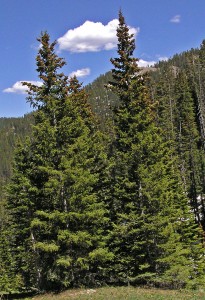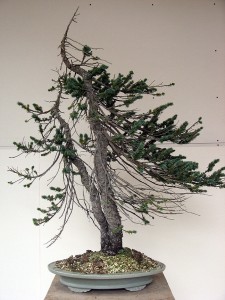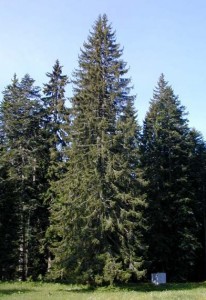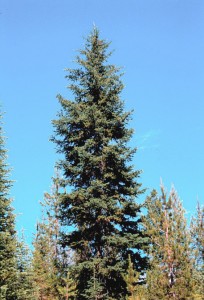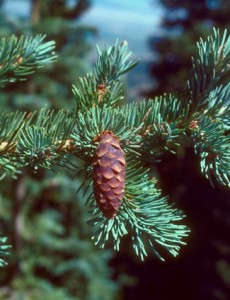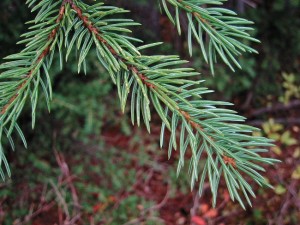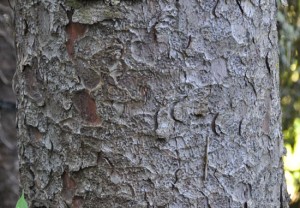Engelmann Spruce
Engelmann spruce is a medium- to large-sized evergreen conifer indigenous to the western parts of North America, typically growing at high altitudes between 3,000 ft and 11,980 ft (900 m and 3,650 m). These spruce trees have a pyramidal crown with a slightly rounded top and their branches extend to the ground, giving the whole tree a low, shrubby look.
Scientific Classification
| Kingdom | Plantae |
| Division | Pinophyta |
| Class | Pinopsida |
| Order | Pinales |
| Family | Pinaceae |
| Genus | Picea |
| Scientific Name | Picea engelmannii |
Quick Information
| Other Names | Silver spruce, white spruce, Columbian spruce, pino real, mountain spruce |
| Size | 25-40m (82-130ft) tall, occasionally grows up to 65m (213ft); trunk diameter of about 1.5m (4.9ft) |
| Leaves | Needle-like, borne singly, 15-30 mm long, glaucous blue-green above and blue-white below, 4-angled; arranged in a crowded manner on upper side of the branches; several stomatal lines on upper parts and two broad stomatal bands below |
| Cones | Ellipsoidal, pendulous, 4-8 cm long, 3 cm broad when open, violet to dark purple, turn into buff-brown with maturity; cone scales are small, papery, flexible, with wavy margins, 15-20 mm long |
| Bark | Reddish-brown to purple-brown, thin, scaly, flakes off in circular plates; with stout, yellowish-brown twigs having conspicuous pulvini |
| Distribution/Range | British Columbia, Alberta, all the western states of United States, Arizona, New Mexico; distributed in the Selkirk, Cascades, Monashee and Rocky Mountain ranges, also in the mountainous regions of the Interior Plateau |
| Hardiness Zones | 2-5 |
| Growth Rate | Slow; average annual increase in height is less than 12 inches |
| Lifespan | 250-450 years old; some may live for 500-600 years |
| Growing Conditions | Winter Conditions: Grows in places with freezing winters and temperatures dropping below -50° F (-45.6° C) Summer Conditions: Areas where summers are short, cool, and dry with temperatures rising above 90° F (32.2° C) Rain: Needs an average yearly rainfall of more than 24 inches (61 cm) Sunlight: Both full and partial sunlight Soil Requirements: Deep, well-drained, clay loam and silt, silts and loamy sand soils; also on alluvial and glacial soils with ample moisture |
| Diseases and Pests | Wood rots caused by fungi such as Flammula alnicola, Phellinus nigrolimitatus, Coniophora puteana, Polyporus tomentosus var. curnatua; trunk rots caused by Amylosterceum chailletti, Echinodontium sulcatum, Haematosterceum sanguinolentum, and Phellinus pini; spruce broom rust causes loss of volume and deformation of trunks; matured trees are attacked by spruce beetles; western spruce budworms also cause damage |
| Flowering/Fruiting | Strobili are formed during late April-early May; ripening of male flowers and scattering of pollens take place during late May-early June at low altitudes, and during mid June-early July at higher altitudes |
| Seed production | Cones are borne when the tree is 15-40 years old and 4-5 ft tall; cones start opening in September, and the seeds are shed by October |
| Seedling development | Seeds germinate after the winter snow melts when the temperature is more than 45° F (7° C), and the ground is moist |
| Wildlife Value | Pine grosbeaks, black-capped chickadees, red-breasted nuthatches, pine siskins, and white-winged crossbills feed on spruce seeds; porcupines and black bears occasionally bite the bark; grouse and red squirrels sometimes eat the new buds |
| Subspecies and Cultivars |
|
| Uses | Its lumber is used for home construction, paper-making, plywood manufacture, pre-fabricated wood products; occasionally for making food containers; tonewoods for musical instruments including harps, guitars, pianos, and violins; widely used as Christmas trees |
| IUCN Conservation Status | Least Concern |
Comparison with Sitka and Blue Spruce
Engelmann spruce vs. Sitka spruce: Unlike Engelmann spruce that has four-sided needles, the Sitka spruce has flattened needles.
Engelmann spruce vs. Blue spruce: Blue spruce needles are sharper than that of Engelmann spruce; as compared to blue spruce, Engelmann spruce has a thinner bark.
Care
- The seedlings with roots should be planted in damp soil, and the area should be protected by logs, stumps, or live vegetation. If the protective cover is not significantly high, the planting spot should be at a distance of 2-3 inches from the protective cover.
- Plant by digging holes using hand tools including power augers and mattocks.
- New plantings require protection from livestock as well as rodents. Therefore, plantations should be adequately fenced, and rodent control measures should be taken until the seedlings have grown and become well-developed.
Interesting Facts
- This spruce tree has a shallow root system, and hence, it is at risk of being overthrown or uprooted by the wind.
- A type of beverage, known as the spruce beer, has been produced from the twigs and needles of Engelmann spruce. In the past, it was consumed for the prevention of scurvy.
References:
- https://en.wikipedia.org/wiki/Picea_engelmannii
- https://extension.usu.edu/rangeplants/shrubs-and-trees/engelmann-spruce
- https://www.conifers.org/pi/Picea_engelmannii.php
- https://www.for.gov.bc.ca/hfd/library/documents/treebook/engelmannspruce.htm
- https://www.wood-database.com/engelmann-spruce/
- https://tidcf.nrcan.gc.ca/en/trees/factsheet/286


